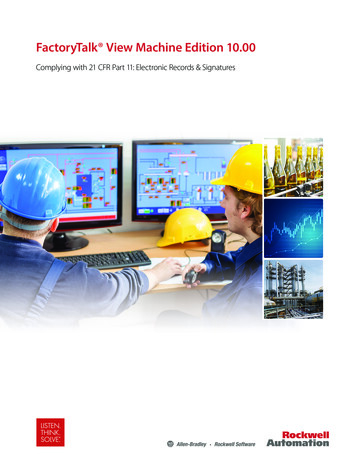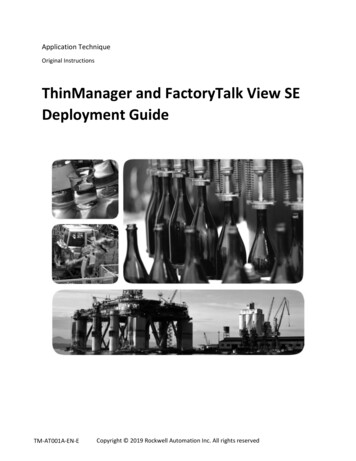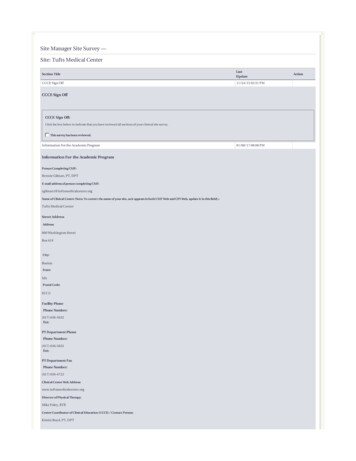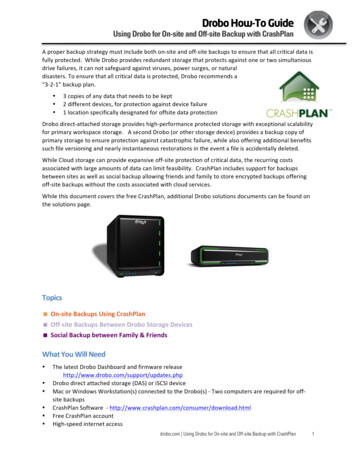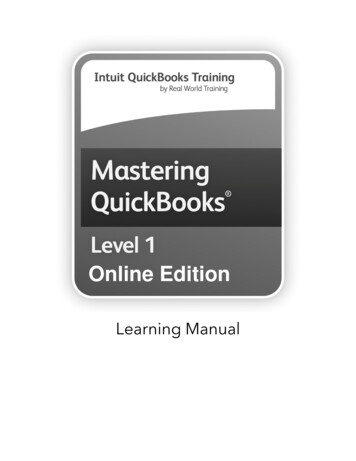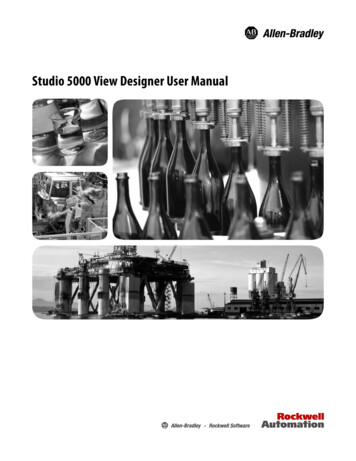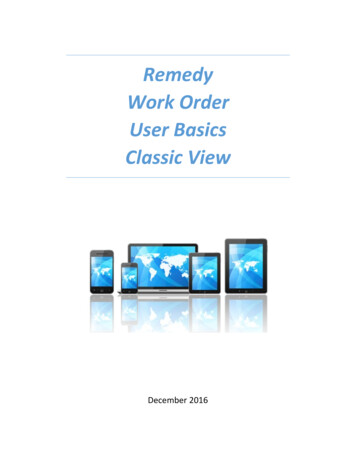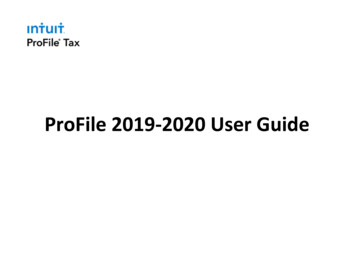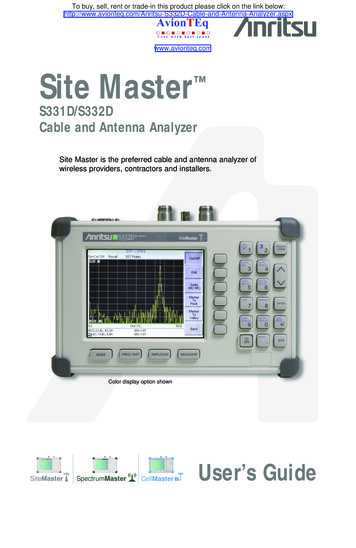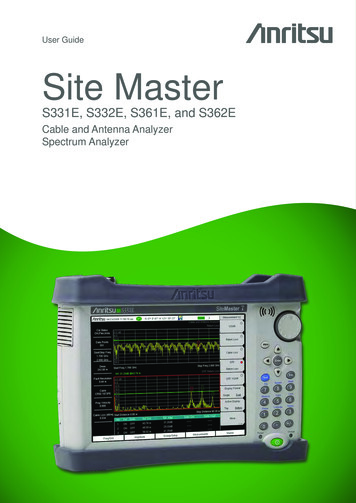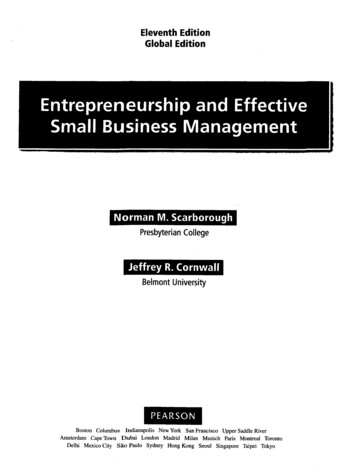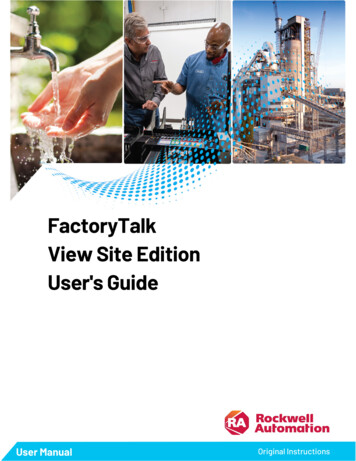
Transcription
FactoryTalkView Site EditionUser's GuideUser ManualOriginal Instructions
FactoryTalk View Site Edition User's GuideImportant User InformationRead this document and the documents listed in the additional resources section about installation, configuration, andoperation of this equipment before you install, configure, operate, or maintain this product. Users are required to familiarizethemselves with installation and wiring instructions in addition to requirements of all applicable codes, laws, and standards.Activities including installation, adjustments, putting into service, use, assembly, disassembly, and maintenance are required tobe carried out by suitably trained personnel in accordance with applicable code of practice.If this equipment is used in a manner not specified by the manufacturer, the protection provided by the equipment may beimpaired.In no event will Rockwell Automation, Inc. be responsible or liable for indirect or consequential damages resulting from the useor application of this equipment.The examples and diagrams in this manual are included solely for illustrative purposes. Because of the many variables andrequirements associated with any particular installation, Rockwell Automation, Inc. cannot assume responsibility or liability foractual use based on the examples and diagrams.No patent liability is assumed by Rockwell Automation, Inc. with respect to use of information, circuits, equipment, or softwaredescribed in this manual.Reproduction of the contents of this manual, in whole or in part, without written permission of Rockwell Automation, Inc., isprohibited.Throughout this manual, when necessary, we use notes to make you aware of safety considerations.WARNING: Identifies information about practices or circumstances that can cause an explosion in a hazardous environment, which may lead topersonal injury or death, property damage, or economic loss.ATTENTION: Identifies information about practices or circumstances that can lead to personal injury or death, property damage, or economic loss.Attentions help you identify a hazard, avoid a hazard, and recognize the consequence.IMPORTANT Identifies information that is critical for successful application and understanding of the product.Labels may also be on or inside the equipment to provide specific precautions.SHOCK HAZARD: Labels may be on or inside the equipment, for example, a drive or motor, to alert people that dangerous voltage may be present.BURN HAZARD: Labels may be on or inside the equipment, for example, a drive or motor, to alert people that surfaces may reach dangeroustemperatures.ARC FLASH HAZARD: Labels may be on or inside the equipment, for example, a motor control center, to alert people to potential Arc Flash. Arc Flashwill cause severe injury or death. Wear proper Personal Protective Equipment (PPE). Follow ALL Regulatory requirements for safe work practices andfor Personal Protective Equipment (PPE).2Rockwell Automation Publication VIEWSE-UM006O-EN-E - September 2020
Table of ContentsChapter 1Getting started withFactoryTalk View SEWelcome to FactoryTalk View SE . 29About FactoryTalk systems . 29FactoryTalk Services Platform . 29Finding more information about FactoryTalk services . 30FactoryTalk View Site Edition software . 30FactoryTalk View SE features.32Quick start: setting up the software you need . 33Step 1: Plan the layout of the network . 33Step 2: Install FactoryTalk Services Platform . 34Step 3: Install FactoryTalk View SE. 34Step 4: Select the connectivity options . 34Step 5: Install the necessary activation keys . 35Step 6: Set up the FactoryTalk Directory .36Exploring the InstantFizz application .36Creating a FactoryTalk View SE application . 38Step 1: Create the application . 38Step 2: Create a graphic display . 40Step 3: Test run the application in FactoryTalk View SE Client . 40Chapter 2Exploring FactoryTalk ViewStudioAbout FactoryTalk View Studio . 43Start FactoryTalk View Studio using a command . 43Command-line parameters and examples.44About FactoryTalk Security permissions .44Opening an application in FactoryTalk View Studio .44Resolving access problems to the HMI Projects folder .45Opening the InstantFizz application .45Parts of the FactoryTalk View Studio main window . 46Workbook mode . 46Showing and hiding items in the main window . 46Working in the Explorer window .47Moving the Explorer window .47Opening and closing folders . 48Organize graphic displays . 48Opening component editors . 48Creating and modifying components . 49Adding components to an application . 50Naming components . 50Using component names that contain spaces . 51Rockwell Automation Publication VIEWSE-UM006O-EN-E - September 20203
Table of ContentsAvoiding names that conflict with commands or macros . 51Deleting, removing, and renaming components . 51Restoring a component . 52Techniques for working in editors . 52Gaining quick access to common operations . 52Browsing lists and components . 52Supplying tag names. 52Selecting and building commands . 53Building expressions. 53Printing from FactoryTalk View SE .54Selecting a printer .54Printing at run time .54Chapter 3Planning an application4Understanding the process you are automating . 55Planning the network layout . 55Choosing a Windows domain or workgroup .56Windows workgroups .56Determining computers needed.56Planning communications . 58Determining how to access data . 58Collecting only the necessary data . 58Monitoring and controlling alarms .59Planning an alarm monitoring and control system .59Advantages of using FactoryTalk Alarms and Events services .59Choosing device-based alarms .59Choosing server tag-based alarms. 60Deciding when to use HMI tags . 60Designing the HMI tag database . 60Organizing HMI tags . 60Designing a dependable control system . 61Planning how to secure the system . 61Planning to use built-in system availability features . 61About redundant application servers . 62Setting up the run-time application . 62Developing a hierarchy of graphic displays .63Creating templates to ensure consistency .63Planning the multi-monitor deployment .63Applying visual design principles . 64Planning how to use trends .65Planning run-time language switching .65Designing a system that is easy to deploy and maintain .65Rockwell Automation Publication VIEWSE-UM006O-EN-E - September 2020
Table of ContentsDesigning the application for multiple users . 66Designing applications for multiple monitors . 66Integrating with other applications and customizing the system . 68Chapter 4Setting up the FactoryTalkDirectoryAbout FactoryTalk Directory . 69FactoryTalk Directory in a networked system . 69FactoryTalk Directory in a FactoryTalk View SE application . 70Local station applications . 71Network applications. 72Specifying the FactoryTalk Directory server location . 73Setting up FactoryTalk Directory for local station applications . 75What happens if the Network Directory server is unavailable . 75Monitoring the Network Directory status . 75Chapter 5Setting up securityAbout FactoryTalk Security services. 77About the FactoryTalk Directory . 78Finding more information about FactoryTalk Security . 78Gaining initial access to a FactoryTalk system . 78About the All Users account.79Logging users on to and off from FactoryTalk View SE . 80Logging on to the FactoryTalk Directory . 80About single sign-on . 80Logging on to FactoryTalk View Studio . 81Logging on to a FactoryTalk View SE Client . 81Logging on when the client starts up . 81Changing the current user while the client is running. 82Logging on a different user . 82Logging off the current user at run time . 82Changing the current user’s password at run time . 83Deciding how to secure a FactoryTalk View SE application . 83Securing FactoryTalk View SE applications at run time. 84Securing FactoryTalk system resources . 85Setting up FactoryTalk accounts in FactoryTalk View SE . 86Setting up accounts in the Runtime Security editor . 86Example: Setting up run-time access to HMI components . 88Removing All Users from the Runtime Security list. 89Specifying login and logout macros . 89Removing Runtime Security accounts . 91Setting up run-time security for HMI project components . 91Assigning security codes to commands and macros. 91Rockwell Automation Publication VIEWSE-UM006O-EN-E - September 20205
Table of ContentsAbout the Unspecified Command . 92Assigning security codes to graphic displays. 92Assigning security codes to OLE objects .93Assigning security codes to HMI tags .93Other ways to control run-time access to an application. 94Lock operators into the run-time environment . 94Use electronic signature to control user actions .95About FactoryTalk Security accounts .95About the All Users account.95Specifying which users can set up security . 96Choosing the types of accounts to use . 96Using accounts that originate at the FactoryTalk Directory .97Using Windows-linked accounts .97Using both types of user account .97Creating group accounts .97Setting up user and computer accounts . 98Creating computer accounts for network applications . 99Setting up system-wide policies . 100Product policies . 101Use HTTPS protocol. 101Add an HTTPS binding for your site . 103System policies . 103Setting up security for FactoryTalk system resources. 104Modifying FactoryTalk Security settings . 105Specifying which actions users can perform . 106About explicit and implicit permission . 107Organizing actions into groups . 107Understanding inherited permissions .108Breaking the chain of inheritance .108Using explicit permissions to override inheritance . 109Performing secured tasks in FactoryTalk View SE . 110Example: Using the Common actions to set up security for usergroups . 111Chapter 6Working with networkdistributed applications6About network distributed applications .113Parts of a network distributed application . 114About FactoryTalk systems . 115Finding more information about FactoryTalk services . 115Key concepts . 115FactoryTalk Network Directory . 115FactoryTalk Security . 116Rockwell Automation Publication VIEWSE-UM006O-EN-E - September 2020
Table of ContentsAbout FactoryTalk Security permissions . 116HMI servers . 116HMI projects . 116HMI clients .117Areas .117Absolute and relative references .117Absolute reference syntax . 118System availability . 119About HMI server redundancy . 119Language switching .120Creating network distributed applications .120Adding areas and servers .120Adding and deleting areas .120Adding an HMI server . 121Adding a data server . 121Adding a Tag Alarm and Event Server. 122Deciding when to use multiple servers . 122Adding servers for redundant operation . 122Adding servers for load balancing . 123Running multiple HMI servers . 123Providing HMI server names . 123Monitoring disk space on HMI servers . 123Setting up HMI server properties . 124Changing the name of the host computer . 124Choosing how the server starts . 125Starting the HMI server when the first client connects to it . 125Starting the HMI server when the operating system initializes. 125Setting up HMI server redundancy . 125Selecting the secondary server . 125Replicating changes to the standby HMI server . 126Selecting startup and shutdown components . 127Starting and stopping HMI server components manually . 128Monitoring the status
Read this document and the documents listed in the additional resources section about installation, configuration, and operation of th
